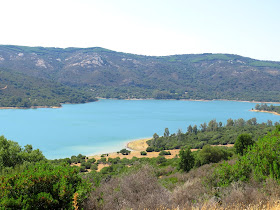First spotted on a Wednesday
morning by a sharp eyed visitor (who originally thought it was an Ortolan
before realising the true magnitude of the find) and with only a brief sighting
two days later at Friday lunchtime, it seemed unlikely that many would be able
to connect with the Cretzschmar’s Bunting that was teasing birders on Bardsey
Island in Wales. With boat loads drawing a blank for the rest of Friday and
with no sign at all on the Saturday, it seemed the likely option that this mega
Bunting had slipped through the net and departed.
It came as some surprise
therefore when I awoke early on Sunday morning to see a report had just come on
that the bird had been seen again that morning at the lighthouse compound – on several
occasions. With a second message confirming that it had returned to the same
spot 5 times that morning and had even been singing, I made a quick on the spot
decision that this (like the recent Citril Finch) was a bird not to be missed
and managed to persuade Alex that we needed to at least try our luck – he who
dares wins after all….
After a 3 hour journey and arriving
15 minutes before the first scheduled boat departure, I was expecting a mass of
birders to greet us at the boat platform with all the places already taken – therefore
it was a bit of a shock when the ramp leading to the sea was completely deserted
and there were just 7 other birders waiting in the boat! Everyone had either clearly
been put off by the fact the bird had so far been extremely unreliable during
its stay, or the first come first serve basis of the crossings had deterred
them!
Either way, half an hour later
we had landed on the beautiful Bardsey Island, departing amongst Grey Seals and
seabirds and ready to make the short ten minute walk through the carpet of wild
flowers and up the lighthouse compound where the bird had been favouring.
Joining a small nervous crowd
who hadn’t yet connected and with seed now having been laid down on the paving
slabs that morning by the observatory staff, we were told the bunting had flown
in to a small patch of clover and flowers to the left hand side of the wall - and as of yet hadn’t been seen to exit. However,
after ¾ of an hour anxiously waiting for the bird to reveal itself but with no
sign at all, it began to cross my mind that our bunting may indeed have slipped
away unnoticed.
 |
| The lighthouse compound where the bird was favouring |
A small brown bird flitting
down from the lighthouse suddenly caught my eye, and raising my bins I was
greeted with the stunning male Cretzschmar’s! The gorgeous slate grey head was
clear to see, as were the rusty orange underparts, moustache and throat patch-
much darker in colouration than the similar Ortolan. Getting all those
assembled on it, we enjoyed excellent but brief views as it fed amongst the Sea
Thrift, hopping between the paving stones for several minutes before flying off
around the corner of the lighthouse building and out of sight!
Relieved and elated at being
the first boatload to successfully twitch the bunting, we enjoyed views once
again half an hour later when the second boat arrived, and it soon became clear
that it was following a pattern of feeding on the seed for 2-3 minutes before
disappearing for 60-90 minutes at a time.
With the bunting vanishing
towards the inaccessible area of the lighthouse once again, we headed over to
the observatory to take a look around the island before our scheduled boat
departed. Several Chough were busy feeding on the turf offering excellent
views, whilst Manx Shearwaters cruised past on the distant waves as Peregrine
Falcons patrolled the cliffs.
An absolutely stunning location
in the glorious summer weather, Bardsey was a fantastic place to spend a sunny
afternoon, and a huge thanks must go out to the brilliant staff there who put
in so many hours relocating the bunting after it did its disappearing act (it
was first seen at the other end of the island) and subsequently managing to get
so many birders to connect in what has been a really well organised twitch.
 |
| Someone was happy to connect |
 Only the 6th record
for Britain ever, this has solely been a Shetland/Orkney bird before now, meaning
this accessible individual (once pinned down) was extremely welcome for many!
With half of all records occurring in the last 7 years and with another bird currently
present in Finland, it may yet become a more frequent visitor to the UK over
the years.
Only the 6th record
for Britain ever, this has solely been a Shetland/Orkney bird before now, meaning
this accessible individual (once pinned down) was extremely welcome for many!
With half of all records occurring in the last 7 years and with another bird currently
present in Finland, it may yet become a more frequent visitor to the UK over
the years.
Since the Sunday, every
boatload of birders appears to have connected and this is down to the hard work
by everyone at the observatory coupled with Colin the boatman’s efforts in
getting everyone across. Still present and into its 10th day
(closing in on the record 11 day stay by the very first Fair Isle bird in 1967)
it is likely that this individual will continue to wow the crowds and draw
people to visit this fantastic island for days to come!

















































